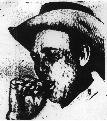Rancher "Mac" Brazel's Unusual Find
Back in central New Mexico, sheep-rancher William "Mac" (or "Mack") Brazel was foreman of the Foster Ranch (often also called the Brazel Ranch). He lived alone in a "shack" in the "middle of nowhere" without electricity, phone, or radio and 30 miles from the nearest town of any size (Corona). The only time he heard news of the outside world was when he went into nearby towns such as Corona or Roswell for supplies. Brazel was thus completely unaware at first of the reports of the so-called "flying saucers" circulating in the nation's press.
On July 2 and July 4, weather records indicate thunderstorm activity in central New Mexico where Brazel lived. According to interviews with his son Bill Brazel Jr. and Roswell intelligence chief Major Jesse Marcel, Brazel heard a loud explosion during a violent electrical storm late at night. Other weather records show no such storm activity in mid-June when Brazel was later alleged to have first found crash debris.
Marcel was also to associate the exploded saucer with one seen by Mr. and Mrs. Dan Wilmot the night of July 2 flying over Roswell in the direction of the Foster Ranch. When Marcel spoke to the Wilmot's son, Paul, around 1980, he said he was told the Wilmots had actually seen the object explode off in the distance. (See Wilmot's July 2 sighting) Marcel added that Brazel then came into Roswell a few days later.
The next day (presumably either July 3 or July 5), Brazel went out to investigate and found a large field of debris, particularly metallic debris, in a pasture about 7 or 8 miles from his ranch house.
Brazel visited his nearest neighbors, the Proctors, who lived 10 miles away. (Brazel's ranch was 8,000 acres.) The Proctors said the normally taciturn Brazel was unusually animated and tried to get them to go see what he had found. Brazel told them the debris had strange properties. He was unable to cut any of it with a knife and it was covered with strange symbols. He also brought a sample with him, a small, tan-colored, dowel-shaped piece. Loretta Proctor said it looked something like balsa-wood, but lacked a grain, was very smooth, and exceptionally hard. They could not cut or mark it with a knife. It was also unaffected by flame. Loretta Proctor said that Brazel also described foil-like debris, which he could wad up in his hand only to have it spring back to its original shape. (See debris descriptions for more)
The Proctors' testimony is important for two reasons. It provided a first-hand account of the strange, damage-resistant wood-like debris which matched those provided independently by William Brazel Jr. and Major Marcel. And second, it tells us something about what Brazel actually found and his state of mind prior to the entry of the military into the case.
The Proctors suggested to Brazel that maybe he had found the remains of one of those flying saucers they had just heard about. They suggested he report it to the authorities and perhaps collect a reward that was being offered for finding one.
Brazel also reportedly went into Corona on the night of July 5. There he told his brother-in-law Hollis Wilson about the find and another man from Alamogordo. They too thought that maybe he had found a flying saucer and suggested that he go to Roswell and report it.
Brazel Goes to Roswell
Probably the next morning, Sunday, July 6, Brazel drove to Roswell and reported his discovery to Sheriff George Wilcox. According to Wilcox family members, Brazel also brought debris samples, which Wilcox held in his office. Daughter Phyllis McGuire claimed her father said Brazel had brought some of the "memory foil" with him and he thought Brazel's discovery very important. (However, wire bulletins from 1947 have Wilcox denying Brazel brought anything with him.) Some Wilcox family members stated that men from the base later came to Wilcox's office and confiscated the debris samples. These may later have been flown out that night (see next page).
According to one account, while Brazel was relating his story, reporter Frank Joyce at Roswell radio station KGFL happened to call Wilcox's office looking for news. Joyce,. however, thinks Brazel actually called him at the station while he was in the middle of doing one of his programs. Joyce managed to interview Brazel and get his original story, which he wouldn't reveal for many years, other to say that it was very different from the one Brazel later related to the press while under military escort.
In 1998, researchers Tom Carey and Don Schmitt reported that Joyce had told them a good deal more about his first contact with Brazel. According to Joyce, Brazel was enormously upset about the large quantity of debris that needed to be cleaned up. More remarkably, Joyce claimed that Brazel then really seemed to "lose it," saying he also found small, non-human bodies ("little people") with an awful stench. Brazel described the situation as "horrible."
When I personally spoke to Joyce recently, he told me the same story -- he claimed that when Brazel first went to Roswell he spoke of finding bodies giving off "terrible odors." To Joyce's suggestion that maybe they were monkeys from White Sands, Brazel allegedly replied, "They're not monkeys. They're not human!"
Joyce said he found Brazel's story hard to believe, but suggested he contact the Roswell air base, who were responsible for all things flying.
Joyce further told me that he didn't tell anyone about Brazel's story because he didn't think he would be believed. Furthermore, even if Brazel's story was true, he didn't know what the "creatures" might be. Conceivably it might be damaging to the country.
